

How to Identify Revolutionary War Musket Balls. Musket balls are one of the earliest forms of bullets that are fired from muskets and rifles.
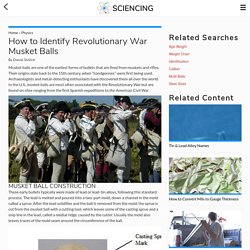
Their origins date back to the 15th century, when “handgonnes” were first being used. Archaeologists and metal-detecting enthusiasts have discovered them all over the world. In the U.S., musket balls are most often associated with the Revolutionary War but are found on sites ranging from the first Spanish expeditions to the American Civil War. Musket Ball Construction. Seed Beads in the Northwest. In which J.
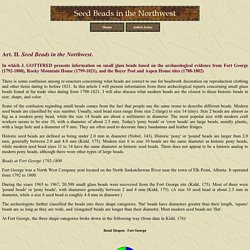
GOTTFRED presents information on small glass beads based on the archaeological evidence from Fort George (1792-1800), Rocky Mountain House (1799-1821), and the Boyer Post and Aspen House sites (1788-1802) There is some confusion among re-enactors concerning what beads are correct to use for beadwork decoration on reproduction clothing and other items dating to before 1821. In this article I will present information from three archeological reports concerning small glass beads found at fur trade sites dating from 1788-1821. I will also discuss what modern beads are the closest to these historic beads in size, shape, and color. Some of the confusion regarding small beads comes from the fact that people use the same terms to describe different beads. Historic seed beads are defined as being under 2.0 mm in diameter (Nobel, 143).
Beads at Fort George 1792-1800. Parks Canada - Canadian Historic Sites: Occasional Papers in Archaeology and History No. 1. Historic Bottle Website - Homepage. Welcome to the BLM/SHA Historic Glass Bottle Identification & Information Website!
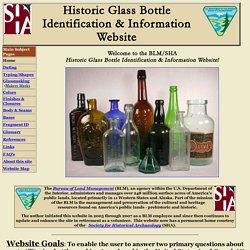
Website Goals: To enable the user to answer two primary questions about most utilitarian bottles and jars* produced in the United States (and Canada**) between the late 1700s and 1950s, as follows: The above two questions also address what was succinctly articulated in the Intermountain Antiquities Computer System (IMACS) and the nominal purpose of this website, which is “…to provide archaeologists with a manual for a standard approach to arriving at historical artifact function and chronology” (University of Utah 1992). This entire website is essentially a "key" - albeit a complex one - to the dating and typing (typology) of historic bottles. In addition, this site also assists the user with these questions: 3. This site instead attempts to help the user determine some key facts - approximate age & function - about any given utilitarian* bottle/jar based on observable physical characteristics. IMACSUsersGuide1992. Glass. A pair of early 19th century wine glasses with etched decoration.

The pair are in excellent original condition. One measures 4 1/8" tall with a top diameter of 2 1/4" and a bottom diameter of 2 1/16". The other is 4 1/16" tall with a top diameter of 2 1/16" and a bottom diameter of 2 1/8"... Any subtle differences are the result of these being hand blown and hand etched. These very closely resemble the pair listed above but the decoration is slightly different. A c.1740 Gin glass with a drawn trumpet shaped bowl and folded foot. A pontilled chestnut bottle in aqua glass. This is a mid 19th century utility bowl or pan. A large red wine glass with very fine and beautiful engraving of grapes on a vine. An 18th century English gin glass with folded foot and balustroid twisted knopped stem . A 19th century open salt. This is an 18th century tumbler with copper wheel engraved decoration of swags and tassels. A 19th century mold blown pan with sunburst decoration.
MSU Campus Archaeology Program. Here at Campus Archaeology we collect a lot of nails.
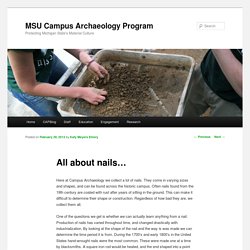
They come in varying sizes and shapes, and can be found across the historic campus. Often nails found from the 19th century are coated with rust after years of sitting in the ground. This can make it difficult to determine their shape or construction. Regardless of how bad they are, we collect them all. One of the questions we get is whether we can actually learn anything from a nail. Thomas Visser from A Field Guide to New England Barns and Farm Buildings Beginning in the 1790’s through the early 1800’s a number of machines were invented in the US for making cut nails. During the 1880’s, machines were developed to produce nails from inexpensive steel wire. Nails found on campus by CAPMSU The question then is so what? Sources Allen. Glasgow Steel Mill. Good thoughts, thank you gents.

Ancient Uses of Ramah Chert. Prehistoric cultures utilized both high and low quality stone for tool making.

When they could get it, they appear to have preferred chert, a fine-grained stone composed mainly of silica. This composition makes the stone brittle and able to fracture with a sharp edge. It was preferred by many flintknappers (or stone workers) because the pattern with which the chert fractured was predictable, producing a better formed tool. There are only two known sources of high quality, flakeable chert along the entire Labrador coast. Historic Bottle Website - Homepage. Welcome to the BLM/SHA Historic Glass Bottle Identification & Information Website!
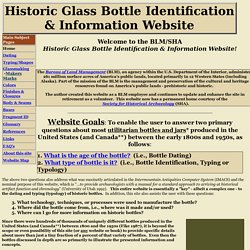
Website Goals: To enable the user to answer two primary questions about most utilitarian bottles and jars* produced in the United States (and Canada**) between the early 1800s and 1950s, as follows: The above two questions also address what was succinctly articulated in the Intermountain Antiquities Computer System (IMACS) and the nominal purpose of this website, which is “…to provide archaeologists with a manual for a standard approach to arriving at historical artifact function and chronology” (University of Utah 1992). This entire website is essentially a "key" - albeit a complex one - to the dating and typing (typology) of historic bottles.
In addition, this site also assists the user with these questions: 3. This site instead attempts to help the user determine some key facts - approximate age & function - about any given utilitarian* bottle/jar based on observable physical characteristics. GlassGlossary. The History of Window Glass Manufacture. The first window glass manufactured in Britain, in Roman times, was broadsheet glass in which an elongated balloon of glass was blown, the ends cut off and the resulting cylinder was split and flattened on an iron plate.
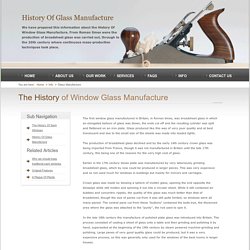
Glass produced like this was of very poor quality and at best translucent and due to the small size of the sheets was made into leaded lights. The production of broadsheet glass declined and by the early 14th century crown glass was being imported from France, though it was not manufactured in Britain until the late 17th century, this being one of the reasons for the very high cost of glass. Earlier in the 17th century blown plate was manufactured by very laboriously grinding broadsheet glass, which by now could be produced in larger pieces. This was very expensive and so not used much for windows in buildings but mainly for mirrors and carriages. 2000 × 2187 - en.wikipedia.org.
